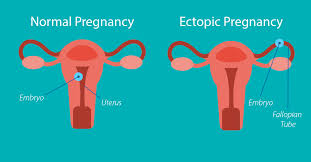Tubal Anastomosis Causes High Risk of Recurrence of Ectopic Pregnancy
The situation that the fertilized eggs implanted outside the uterine cavity is called ectopic pregnancy (EP), and tubal pregnancy is more common. The incidence of ectopic pregnancy in developed countries has reached 2%, which seriously affects women's reproduction and health.
Although safe and effective conservative treatment is available for unruptured ectopic pregnancy, surgery has always been an effective treatment of ectopic pregnancy. The surgical treatment includes salpingectomy, salpingostomy, and tubal anastomosis. However, the effect of surgery on reproductive function is still controversial.

ectopic pregnancy
Recently, a retrospective cohort study was conducted by Dr. Li Jingwei of Shengjing Hospital affiliated to China Medical University. The risk of ectopic pregnancy recurrence after salpingectomy, salpingostomy and tubal anastomosis and the fertility of patients were compared, and the results showed that the rate of intrauterine pregnancy decreased and the risk of ectopic pregnancy recurrence increased within 2 years after tubal anastomosis compared with salpingectomy and salpingostomy, the article was published in BMJ.
A total of 618 cases of tubal pregnancy treated by surgery in Shengjing Hospital from January 2003 to September 2011 were collected. The case information included social demographic characteristics: gender, fertility history, surgical history, gynecological history, smoking habits, methods of conception (such as contraception, ovulation induction), types of ectopic pregnancy, diagnosis and treatment process.
Follow-up of HCG is carried out after surgery until the results turned negative, patients whose HGC increases or enters into the plateau phase were diagnosed as a persistent trophoblastic disease. The main outcome indicators were intrauterine pregnancy (IUP) and recurrent ectopic pregnancy (EP).
Operative indications included hemodynamic instability, suspected rupture of ectopic pregnancy mass, contraindication of methotrexate or failure of conservative treatment. Exclusion criteria: EP history, no follow-up, use of contraceptives, no re-pregnancy plan, patients who have received methotrexate therapy, in vitro fertilization and embryo transfer, intraoperative methylene blue was used to indicate whether the contralateral fallopian tube was unobstructed.

There were 434 cases of salpingectomy, 112 cases of salpingostomy and 72 cases of the tubal anastomosis. The age of the patients was 29.4 years, 28.8 years and 28.1 years, respectively. There was no difference in the age baseline between the missing patients and the visited patients.
The intrauterine pregnancy rate within 24 months after operation was 55.5% (241 cases), 50.9% (57 cases) and 40.3% (29 cases) respectively. Univariate analysis showed that the intrauterine pregnancy rate after salpingostomy was lower than that after salpingostomy, while there was no difference between salpingostomy and tubal anastomosis.
Follow-up HCG showed that the incidence of trophoblast persistence (i.e. blood HCG did not fall to normal within the expected time) after salpingostomy (9.8%) and tubal anastomosis(8.3%) was higher than that in salpingectomy (1.8%).
The cumulative recurrence rates of ectopic pregnancy within 2 years after operation were 8.1% (salpingectomy), 6.3% (salpingostomy) and 16.7% (tubal anastomosis). With salpingectomy as the control group, the risk of recurrent ectopic pregnancy increased in patients undergoing tubal anastomosis.

tubal anastomosis
The tubal anastomosis can preserve the fertility function of patients. The probability of pregnancy after laparotomy is 54%-88%, and laparoscopic surgery is 31%-85%. However, there are few studies comparing the efficacy of other surgical methods. Tan and Loh's studies showed that the pregnancy rates after laparoscopic salpingostomy were 47.4% (within 6 months), 57.9% (within 12 months), 68.4% (between 12 and 48 months) and 73.7% (over 48 months), respectively.
The results show that the recurrence rate of ectopic pregnancy after the tubal anastomosis is higher and the intrauterine pregnancy rate is lower. The reason may be that the surgical scar after tubal anastomosis which can easily cause tubal stenosis and blockage, affect the operation of sperm in the fallopian tube, and lead to the formation of the blastocyst in the fallopian tube.
Clinicians need to consider the contralateral fallopian tube and whether there is an underlying disease to choose surgical methods when they receive young patients with tubal pregnancy who still have fertility requirements. The principle of surgery should be to preserve the fertility of patients and reduce the risk of recurrence of ectopic pregnancy.
For those patients who are worried about the recurrence and great risk after an operation, the conservative natural medicine Fuyan Pill is also a very good treatment method. It has a strong bactericidal effect, can effectively kill all kinds of pathogenic bacteria, eliminate inflammation, and the natural herbs in the formula make it have the functions of clearing heat and detoxification, activating blood circulation and removing blood stasis, and invigorating spleen and dampness.

natural herbs
Fuyan Pill can effectively alleviate the symptoms of abdominal pain and abnormal menstruation. It can not only treat tubal diseases, but also help patients regulate the interior, balance Qi and blood, and improve immunity, so as to achieve the effect of treating both the symptoms and the causes. Best wishes for your recovery!
Testimonials
- Adenomyosis with Ureaplasma Urealyticum Cured by Fuyan Pill
- Tubal blockage with hydrosalpinx can be cured by TCM shortly
- Fuyan Pill Helps A woman with Adenomyosis Get Pregnant
- A Woman with Hydrosalpinx Is Cured with Fuyan pill
- Pelvic Inflammatory Disease Testimonials
- Irregular Vaginal Bleeding and Endometrial Thickening Cured by Fuyan Pill
- Pruritus Vulvae and Frequent Urination: Mycoplasma Infection Cured after 2 Courses



